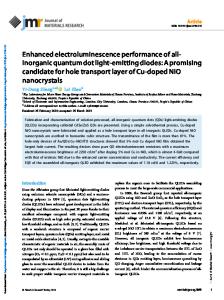Emitting Amorphous Molecular Materials for Electroluminescence Designed
- PDF / 2,871,594 Bytes
- 2 Pages / 612 x 792 pts (letter) Page_size
- 34 Downloads / 319 Views
with transmission electron microscopy, the researchers conclude that the GNF cathode consisted of large numbers of fibers that were about 50 nm in diameter but were not carbon nanotubes. Electrons were drawn from the cold GNF cathode through field emission; that is, a strong electric field between the GNF cathode and the Cu anode pulled the electrons off. The researchers, T. Matsumoto of Stanley Electric Corp. in Yokohama, Japan, and H. Mimura of Tohoku University in Sendai, Japan, chose a simple diode configuration (instead of the usual triode), not only for its superior x-ray generation efficiency but also for its potential advantages in size and cost. To assure that the x-rays would emerge from a point, they restricted the electron bombardment region of the Cu anode by coating all but about 10 µm of the sharpened metal tip with an insulating silicate. Mastumoto and Mimura investigated the current–voltage characteristics of the efficient GNF cathode and also spectrally characterized the point source’s x-ray output using a Ge detector and a multichannel analyzer. Next, they imaged a tungsten mesh and a Pb x-ray test chart in the transmission geometry, where the test object is between the x-ray source and the detector (a charge-coupled device camera with a NaI scintillator). The system achieved a high resolution, roughly 10 µm, with an image acquisition time of 10 s using a charge-coupled device. “There is great interest in building a practical, efficient, high-current-density x-ray device,” said Matsumoto, “and we’ve now developed a simple x-ray radiography system. Since the efficient field-emission process eliminates the usual bulky water-cooling system, this makes possible a portable, compact x-ray system.” RICHARD LOUIE
the Department of Mechanical Engineering at the University of Colorado, Boulder, have developed a model that accounts for the particle size distribution in the powder. Application of this statistical model to the time-dependent oxidation of silicon carbonitride (SiCN) yielded a much more accurate value of the rate constant than that provided by the monosize model. According to Raj, “This improved data analysis technique gives much greater credibility to the simple experimental approach of using powders to study material oxidation rates.” As described in the February issue of the Journal of the American Ceramic Society, the researchers prepared SiCN powder by cross-linking and pyrolyzing Ceraset-SN, a commercially available precursor. The final product was crushed into powder and imaged using scanning electron microscopy. Size measurements from the micrographs were used to generate a histogram of radius values and an average radius value. The SiCN was oxidized in air at 1350°C for 150 h, with the mass of the sample recorded periodically throughout the process. The monosize and statistical models were then fitted to this data. Data analysis with the monosize
model yielded two limiting values for the oxidation rate constant because one rate constant was needed to fit the data for short-term oxida
Data Loading...










